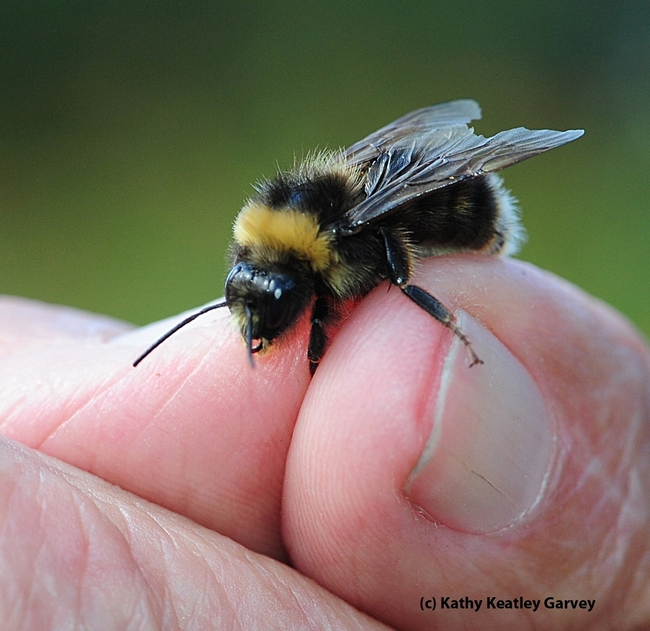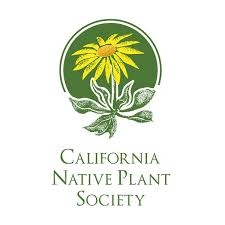By Penny Pawl, U. C. Master Gardener of Napa County
Hello, I am your friend, the queen bumblebee. Also known in scientific terms as Bombus occidentalis. I'll bet you don't know much about me, but I am an important member of the pollinators that are needed in your garden and all the gardens surrounding you. All the vegetables and fruits you eat need pollination and that is where I come in. I'm also the biggest bee you will see in your garden.
I am a fuzzy bee with hair on my body and yellow and orange stripes around it. Occasionally I will come dressed in all black as there are many different bumblebees in my neighborhood. We may look different, but we behave similarly in and around your garden.
The garden where I spend most of my time has a big collection of flowers in bloom with lots of nectar. I like to glide around it looking for pollen to collect for my babies. My favorites are the native plants but I will sample from any I find. I need blooming flowers in every season so I don't starve and can keep feeding my babies.
I love the Salvia microphylla 'Hot Lips' that grows in this garden and will spend hours hovering around its blooms. This sage was discovered growing wild in Mexico, and a horticulturist brought it to the United States.
I like this garden because it has areas not covered with compost or mulch. In those areas, I am able to build a nest in the holes left by rodents or other soil creatures. I make a nest of many tunnels and lay my eggs in them. I have spent the winter in my nest alone, but last fall I mated and now, in the spring, I am expecting about 400 babies. So living in a garden full of flowers is important.
When my first babies grow up, they will help me feed the rest of the family by gathering nectar. These are my daughters or worker bees. I mostly stay at home and lay more eggs which my worker bees help feed.
Unlike the European Honey Bee imported by European settlers, I am a native and have evolved with the native plants. I do not produce honey but devote my life to my offspring and gathering nectar to feed my babies. At the end of the summer only my fellow queens survive to the next spring. As the old queen, I will die, as will the male drones and all my workers. The new queens sleep the winter away in our cozy nest.
I do have a stinger but seldom use it. However, when I or my workers sting someone we can pull the stinger out. It is not barbed like the honey bee's stinger. If the need arises, we can sting again.
One of my most important pollinating tasks is to gather nectar from tomatoes.Tomatoes are self-pollinating, which means the flower has both male and female parts. But the flower needs to be jostled to loosen the nectar. I buzz around the blossoms and shake them to gather pollen and that's how the flower is pollinated. I have noticed that the human in the garden shakes the tomatoes daily. I guess she is afraid I am not doing my job. In hothouses, they bring in bumblebees to do this job.
There are 46 species of bumblebee in the US. We have different markings, but our lifespan and nesting habits are much the same. Toward the end of summer, male bumblebees will hatch. They don't do much in the nest but hang around and grow fat. Then they strike out on their own.
After the males leave, queens are born. Once they mature, they leave the nest and seek out suitable mates. Most of the males never do mate and do not survive the winter. The queens find a nest area and spend the winter sleeping and dreaming of what they will do when spring arrives.
I hope you can understand why you should grow plants that lure us to your garden and keep us well fed. Without bees to keep California's fruits and vegetables pollinated, your own food supply would be a lot more sparse.
Next workshop: “Succulents Celebration!” on Saturday, July 20, from 9:30 a.m. to 11:30 a.m., at the University of California Cooperative Extension, 1710 Soscol Avenue, Napa. Learn why succulents have become the trendiest members of the plant kingdom. For more details & online registration go to http://napamg.ucanr.edu or call 707-253-4221.
The UC Master Gardeners are volunteers who provide UC research-based information on home gardening and answer your questions. To find out more about upcoming programs or to ask a garden question, visit the Master Gardener website (http://napamg.ucanr.edu) or call (707) 253-4221 between 9 a.m. and noon on Mondays, Wednesdays or Fridays.
Attached Images:

